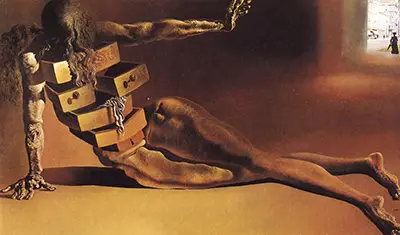Dali's work on The Anthropomorphic Cabinet was a largely influenced by Sigmund Freuds work that explains that the human body is made up of secret drawers that can only be told by the study of the unconscious mind. This interpretation by Sigmund Freud was after he had read a novel that explained study of unconscious mind. The study explained that the small cabinets are combined to form body parts. The painting was done in the year 1936. He used a pencil to make a first sketch on a white coloured wood then he did the final painting in ink. In 1979, Dali decided to make a sculpture of the painting. The Anthropomorphic Cabinet in size was 60 by 30 centimetres and was made of bronze with a dark thin layer of patina formed on it due to its age. Dali was assisted by Marcel Duchamp to modify a plaster cast of the Venus de Milo; an ancient Greek statue done by Alexandros of Antioch to form the Anthropomorphic cabinet.
The cabinet Dali formed is a female figure that is seated down with the drawers covered with fur. Her head leans forward and the hair falls downwards covering the face. The hand is stretched out to depict rejecting and some of her drawers are partially pulled out. The drawers that are open have their keys placed inside. The upper part of her body that consists of the chest is full of darkness and only the drawer handles that indicate her nipples can be seen. Dali was a great admirer of Sigmund Freud who was a psychoanalysis doctor and praised him by saying that the only difference between old people and new era is Sigmund Freud who discovered that the human body is full of secret drawers only to be opened by psychoanalysis. The drawers to him resembled the subconscious mind that is within. In the 17th century the Italian mannerist called Bracelli was known to use the furniture figures. The familiarity of their use by Dali also influenced use of drawers in his figures especially the Anthropomorphic Cabinet. The cabinet can be seen in Gala-Salvador Dali Foundation in Spain.

